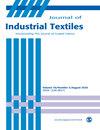Effects of air gap and compression on the dual performance of multilayer thermal protective clothing under low radiant heat
IF 2
4区 工程技术
Q1 MATERIALS SCIENCE, TEXTILES
引用次数: 0
Abstract
An air gap in thermal protective clothing (TPC) plays an important role in determining heat transfer, but it may also increase the amount of stored thermal energy that would discharge to the skin after exposure, especially when the TPC suffers compression. To investigate the effect of air gap and compression on the dual thermal protective performance (TPP), thermal hazardous performance (THP) and overall thermal protective performance (OTPP) of TPC, nine air gap configurations with different sizes and positions and five compression levels were designed in this study. Regression models were established to explore the relationships among air gap size, compression and THP for different air gap positions. The results demonstrate that increasing the air gap size without exceeding 12 mm not only significantly enhances the TPP by impeding heat transfer from the heat source to the fabric system during exposure but also decreases the THP by reducing heat discharge from the fabric system to the sensor even when compression is applied. Although an inner air gap contributes more to increasing the TPP during exposure than an outer air gap, it may also bring about severe stored energy discharge when compression is applied. It suggests that a larger air gap size should be divided into individually separate air gaps within different fabric layers to reduce the heat transfer during exposure as well as lower the stored thermal energy discharge after exposure.气隙和压缩对低辐射热下多层热防护服双重性能的影响
热防护服(TPC)中的空气间隙在决定热量传递方面起着重要作用,但它也可能增加暴露后释放到皮肤上的热能储存量,尤其是当热防护服受到挤压时。为了研究气隙和压缩对 TPC 的双重热防护性能(TPP)、热危险性能(THP)和整体热防护性能(OTPP)的影响,本研究设计了九种不同大小和位置的气隙配置以及五种压缩级别。研究建立了回归模型,以探讨不同气隙位置的气隙尺寸、压缩率和 THP 之间的关系。结果表明,在不超过 12 毫米的情况下增大气隙尺寸,不仅能在曝晒过程中阻碍热源向织物系统的热量传递,从而显著提高 TPP,而且还能在施加压缩的情况下减少织物系统向传感器的热量排放,从而降低 THP。虽然内部气隙比外部气隙更有助于提高曝晒期间的 TPP,但它也可能在施加压缩时带来严重的存储能量释放。这表明,应将较大的气隙尺寸划分为不同织物层内独立的气隙,以减少暴露期间的热传递,并降低暴露后的存储热能释放。
本文章由计算机程序翻译,如有差异,请以英文原文为准。
求助全文
约1分钟内获得全文
求助全文
来源期刊

Journal of Industrial Textiles
MATERIALS SCIENCE, TEXTILES-
CiteScore
5.30
自引率
18.80%
发文量
165
审稿时长
2.3 months
期刊介绍:
The Journal of Industrial Textiles is the only peer reviewed journal devoted exclusively to technology, processing, methodology, modelling and applications in technical textiles, nonwovens, coated and laminated fabrics, textile composites and nanofibers.
 求助内容:
求助内容: 应助结果提醒方式:
应助结果提醒方式:


